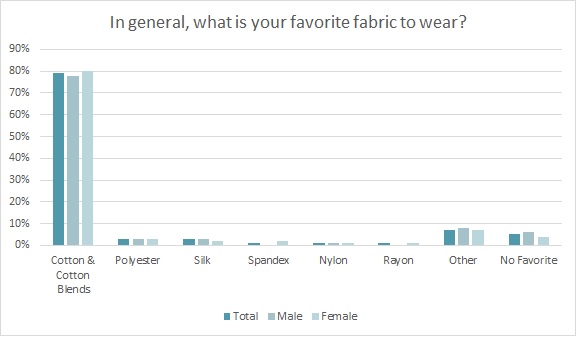There’s a law of science called the Pareto principle, colloquially known as the 80/20 rule, which states roughly 80 percent of the effects come from 20 percent of the causes. But when that principle is applied to people’s closets, it means 80 percent of the time, consumers actually wear just 20 percent of what they own, according to clinical psychologist, wardrobe consultant and author Jennifer Baumgartner. It would make sense then for retailers to offer versatile pieces that shoppers could see playing a part in their wardrobes as they transition from season to season.[quote]
Verena Erin, YouTuber and host of My Green Closet, says versatile wardrobe pieces are important, and describes them as “items that layer really well, can be dressed up or down, worn in multiple seasons or worn different ways.” She has an uncanny ability to wear a T-shirt dress at least eight different ways.
Of course, versatile must-have items differ between men and women — or do they? In GQ’s list of “The 21 Things Every Man Must Have in His Closet,” the top three pieces are a white Oxford shirt, a “great pair” of dark blue jeans and a crewneck shirt. On WhoWhatWear, the top items for women include a crewneck, long-sleeved striped tee (that can be dressed up or down, depending on your need — and your personal styling abilities) and a collared shirt.
All of those items speak to versatility, yet meet consumer preference for items made of cotton. When surveyed, the majority of shoppers (72 percent) say, “If I could spend my life in just one fiber, it would be cotton,” according to the Cotton Incorporated Lifestyle Monitor™ Survey.
Regardless of season, consumers cite cotton and cotton blends (79 percent) as their favorite fabrics to wear, according to Monitor™ data. This far outweighs the next closest fabrics: polyester and silk (both 3 percent) and spandex, nylon, and rayon (all 1 percent).

At Numph, a Denmark-based apparel company, the current spring/summer line is 96 percent cotton, according to Jenn Rodriguez, brand specialist.
“The designers know that in the summertime, people are wearing breathable and lightweight pieces,” she says. “But many of the items can be layered and paired with items from our pre-fall collection. The pre-fall pieces include sweatshirts, shorter skirts, and sweaters made of 100 percent cotton. This way, the collection works when it’s hot, but continues when the temperatures change.”
Not only can versatile apparel work for transitioning seasons, it can work with unpredictable weather patterns.
Planalytics, a Pennsylvania-based weather analytics, software, and services company, says weather conditions and their impact on businesses are only the same from one year to the next about 15 percent of the time. This, the company states, guarantees a “large degree of forecast error for any aspect of retail sales that are heavily weather-influenced.” The company helps quantify weather data to help stores with merchandise planning. It points to both risks and opportunities, based on a store’s location. In 2016, the firm estimated apparel retailers in the U.S. and U.K. lost $572 million in sales the previous holiday season because shoppers shunned winter clothes due to an unseasonably warm November and December.
To help manufacturers and retailers combat the forces of nature, the Fashion Institute of Technology has introduced weather planning into its curriculum. A course called “Predictive Analytics for Planning and Forecasting: Case Studies with Weatherization” aims to educate the next generation of industry players about the highs and lows that come with weather fluctuations.
Meanwhile, some designers have gone the more “seasonless” route, offering apparel that would work just as well for spring as for early winter. Last fall, designer Jason Wu told the Wall Street Journal, “Because of the extreme weather changes, there’s no real separation between spring, fall, winter, and summer.”
At Bamboo Rose, the Massachusetts-based tech company that serves as a digital B2B marketplace for retailers, founder Sue Welch writes that in a New Economy, consumers have the power with more choices and higher expectations than the traditional retail model is equipped to handle.
“With products available whenever and wherever consumers want them, brands that want to thrive need to differentiate, break the barriers of a seasonal mindset and offer new, innovative and exciting products regardless of the calendar date,” she states.
While consumers want interesting, versatile product, most of them also want clothes that are comfortable, to the point that 74 percent say they are unwilling to sacrifice comfort for fashion, according to Monitor™ data. That’s another reason why makers might choose natural fibers like cotton: compared to apparel manufactured with manmade fibers, about 8 in 10 consumers say cotton clothing is the most comfortable (80 percent), sustainable (84 percent), trustworthy (79 percent), soft (81 percent), and authentic (80 percent).
Of course, clothes that can easily transition from season to season are welcome to most consumers’ wallets. Jenna Davis, spent years in the fashion business — from interning with Patricia Field on “Sex and the City” to working at major chains and department stores like Urban Outfitter and Bloomingdale’s — before becoming owner of That Little Black Dress, her boutique in Montclair, NJ. In her experience, customers are primarily interested in trends and the price of the item.
“But if the piece is transitional, they are more enticed to buy it,” Davis says. “It is very important to have apparel that transitions between the seasons so when you are shopping you can get a lot of use out of what you purchase.”
